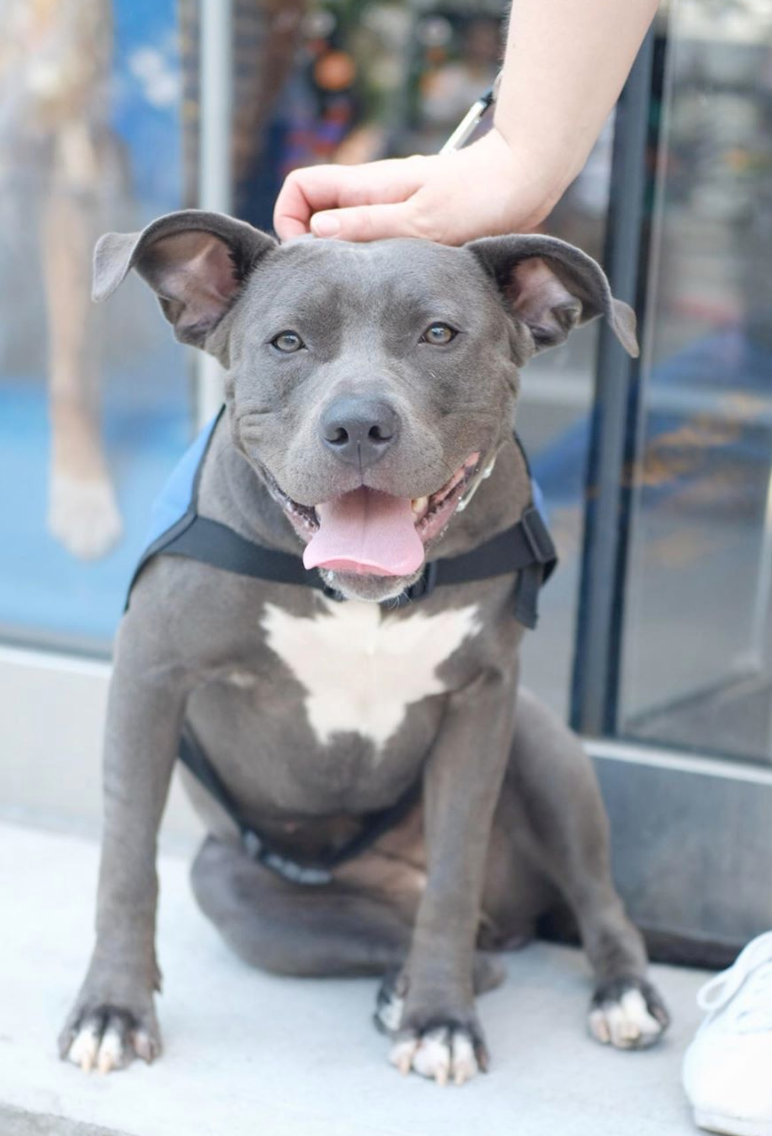The Facts on Fostering Large Dogs and "Bully Breeds"
Source: Alex Lloyd/@adoptabledogsofnyc on Instagram
You may often hear in the rescue world—especially in urban environments like New York City—that organizations are consistently in need of “large dog” and “bully breed” fosters, and that this group of dogs are generally harder to place. Let’s dive into that.
What exactly is considered a “large” dog? And what actually are “bully breeds”? Both are generic terms and don’t have one set definition. Size categories like “large” mean different things to different people, but at Muddy Paws, we generally think of large dogs as those weighing over 60 pounds. “Bully breeds” and the term “pit bull” refer to a group of breeds rather than one specific breed. This group generally includes the American Pit Bull Terrier, Staffordshire Terrier, and the Bull Terrier. Different groups of breeds are included in this category depending on who you ask, but Muddy Paws considers a bully breed to be any dog who looks to have the characteristics of the generic term “pit bull” (since we never actually know each dog’s true genetic makeup)!
Me with Tank—likely the biggest dog I’ve ever photographed! (Source: Alex Lloyd/@adoptabledogsofnyc on Instagram)
Let’s discuss why this population specifically is in need. Unfortunately, some large breeds are associated with negative stereotypes which hurt their reputation and decrease adopters’ and fosters’ willingness to be open to this population of dogs. Often we hear New Yorkers say, “I live in a one bedroom apartment, so I just don’t have the space for a dog larger than 25 pounds.” Surprisingly, larger dogs are often lazier and sleep for a larger portion of the day. The assumption that larger dogs need more space or exercise to be happy is a myth. Take a Greyhound for example: these dogs can be quite large, yet they snooze most of the day away and are perfectly happy with their person and a cozy bed to cuddle up on. Just because you can’t open the back door and let your dog out doesn’t mean that they’re any less happy exploring your local park!
To touch on the needs of our own community, let’s look at the Manhattan Animal Care Center of NYC. The vast majority of the population in our local shelters are large dogs and, more specifically, bully breeds. In the realm of animal rescue, assisting our open-intake shelter partners in the south can arguably be seen as the biggest way to reduce animal homelessness throughout the country. However, it is also our responsibility to help the city that we love so deeply that has its own homeless dog population. This is why we pull from local shelters and organizations as often as our foster availability allows. (Pro tip: When Muddy Paws pulls dogs from our local shelters, we often have more information on these dogs than we do some of our dogs from the south!)
Source: Alex Lloyd/@adoptabledogsofnyc
Now let’s talk logistics. How are larger dogs different on the day-to-day? As a large dog foster myself, I can tell you the following: their crate is bigger, they require more food, you aren’t supposed to take them on the subway or bus, and they produce bigger poops and pees (sorry—it’s true)! But that’s kind of…it. Common concerns that I often hear—that aren’t necessarily true—are that they need more exercise, are difficult on a leash (pulling and reactive), transportation is trickier, and they require a bigger apartment. Yes, a larger dog has the potential to have a stronger pull on a leash than a 15-pound dog, but their larger size does not determine whether they more or less likely to be reactive to other dogs and people while on a leash. You may have to get a little more creative with transportation, but I personally have had great luck with my pittie fosters in Ubers—and as long as they’re well behaved, they’re treated like any other dog!
Source: Alex Lloyd/@adoptabledogsofnyc on Instagram
What are some perks of fostering a large dog? For one, they’re a built-in weighted blanket if you get the snuggly type! They’re often lazier (although not always!), and because they are larger, they can’t monkey under the bed or couch to get into mischief! Most importantly, you get to feel great knowing that you saved the life of a dog that might not have otherwise received a second chance.
If your interest is piqued and you’d like to learn more, you can follow Instagram accounts like mine (@adoptabledogsofnyc), @quinnthecow (Jamie is a Muddy Paws foster who adopted her Great Dane foster, Quinn), @realhappydogs (an adorable family with a loving pittie), and @heart_skipsabeat (a regular large dog Animal Care Centers of NYC foster).
If you’d like to give fostering a try but aren’t quite ready for a 2-3 week commitment, you can take an Animal Care Centers of NYC dog on a “Boroughbreak” (a day away from the shelter) to see how it goes! Additionally, a great book to prepare you for your experience is Pit Bull: The Battle over an American Icon by Bronwen Dickey—it dives deep into the history of the pit bull and how they’re portrayed in society today.
Ultimately, any foster is a little bit of a gamble being that every dog is unique and has their own endearing qualities and challenges. Regardless of who you decide to foster, Muddy Paws will always be there to help as needed—regardless of age, breed, or size!
Alex Lloyd is a Muddy Paws photographer, social and events volunteer team member, and dedicated foster.







